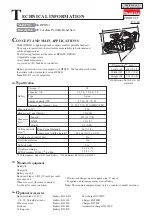
Page 4
WARNING! When using electric
tools basic safety precautions should
always be followed to reduce the risk of
fire, electric shock and personal injury
including the following. Read all these
instructions before attempting to
operate this product and save these
instructions.
KEEP GUARDS IN PLACE and in
working order.
KEEP WORK AREA CLEAN.
Cluttered
areas and benches invite injuries.
DON'T USE IN DANGEROUS
ENVIRONMENT.
Do not use power
tools in damp or wet locations, or
expose tools to rain. Keep work area
well lighted.
Guard against electric shock.
Avoid
body contact with earthed or grounded
surfaces (e.g. pipes, radiators, ranges,
refrigerators).
Make the workshop childproof
with
padlocks and master switches or by
removing starter keys.
KEEP CHILDREN AWAY.
All visitors
should be kept safe distance from work
area.
Store idle tools.
When not in use, tools
should be stored in a dry locked-up
place, out of reach of children.
Do not force the tool.
It will do the job
better and safer at the rate for which it
was intended.
USE RIGHT TOOL.
Don't force tool or
attachment to do a job for which it was
not designed.
WEAR PROPER APPAREL.
Do not
wear loose clothing, gloves, neckties,
rings, bracelets, or other jewelry which
may get caught in moving parts. Nonslip
footwear is recommended. Wear
protective hair covering to contain long
hair.
ALWAYS USE SAFETY GLASSES.
Also use face or dust mask if cutting
operation is dusty. Everyday eyeglasses
only have impact resistant lenses, they
are NOT safety glasses.
Connect dust extraction equipment.
If
the tool is equipped with dust extraction
and collection features, ensure these
are connected and properly used.
Do not abuse the cord.
Never yank the
cord to disconnect it from the socket.
Keep the cord away from heat, oil and
sharp edges.
SECURE WORK.
Use clamps or a vise
to hold work when practical. It's safer
than using your hand and it frees both
hands to operate tool.
Do not overreach.
Keep proper footing
and balance at all times.
MAINTAIN TOOLS WITH CARE.
- Keep cutting tools sharp and clean for
better and safer performance.
- Follow instructions for lubricating and
changing accessories.
- Inspect tool cords periodically and if
damaged have these repaired by an
authorized service center.
- Inspect extension cords periodically and
replace if damaged.
- Keep handles dry, clean and free from
oil and grease.
DISCONNECT TOOLS
before servicing
and when changing accessories such as
blades, bits, cutters and so on.
USE RECOMMENDED
ACCESSORIES.
Consult the Operator’s
Manual for recommended accessories.
The use of improper accessories may
cause risk of injury to persons.
REMOVE ADJUSTING KEYS AND
WRENCHES.
Form a habit of checking
to see that keys and adjusting wrenches
are removed from the tool before turning
it on.
AVOID UNINTENTIONAL STARTING.
Ensure switch is in off position before
plugging in.
Use outdoor extension cords.
When
the tool is used outdoors, use only
extension cords intended for outdoor
use and so marked.
Stay alert.
Watch what you are doing,
use common sense and do not operate
the tool when you are tired.
Use proper extension cord.
Make sure
your extension cord is in good condition.
When using an extension cord, be sure
to use one that is heavy enough to carry
the current your product will draw.
An undersized cord will cause a drop in
line voltage, resulting in loss of power
and overheating. Table 1.1 shows the
correct size to use depending on cord
length and nameplate ampere rating. If
in doubt, use the next heavier gauge.
The smaller the gauge number, the
heavier the cord.
(Continued on page 5)
SAFETY INSTRUCTIONS





































